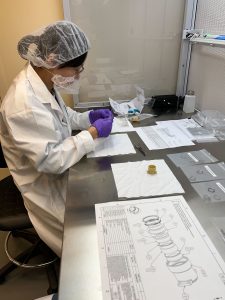
Graduate students Jean-Christophe Fronteddu and Aaron Tohuvavohu proudly displaying the fully assembled LUVCam instrument prior to integration into the GRBBeta CubeSat.
By Ilana MacDonald, Dunlap Institute for Astronomy and Astrophysics, University of Toronto
The European Space Agency’s (ESA) brand-new Ariane 6 rocket had a successful inaugural launch on Tuesday, July 9. Departing from Europe’s Spaceport in French Guiana, the mission carried an array of satellites, experiments, and deployers, including LUVCam — an innovative astrophysical camera funded by the Dunlap Institute and developed across several departments at the University of Toronto.
LUVCam, a high-performance scientific camera payload, has begun its flight on the GRBBeta CubeSat, a 2U nanosatellite weighing less than 3 kg and measuring less than 23 cm along its longest side. LUVCam itself weighs only a quarter of a kilogram and fits in a compact volume not much larger than a deck of cards.

The Exolaunch team places the GRBBeta CubeSat, which houses the LUVCam instrument into the deployer. Its 18mm aperture custom UV telescope, and radiator plate can be seen on the front of the nanosatellite. (Credit: Exolaunch)
LUVCam’s 16-Megapixel Complementary Metal–Oxide–Semiconductor (CMOS) image sensor is sensitive to ultraviolet (UV) and optical light. It is the first sensor of its type in space, with a much higher sensitivity than previous UV cameras. The flight, which will be a Technology Demonstration (Tech Demo) mission, will allow astronomers to measure its performance and the degradation of this type of UV instrument in space.
These results will inform future larger space missions, such as QUVIK — a mission set to observe kilonovae. These cosmic events occur when neutron stars collide, birthing elements heavier than iron.
LUVCam itself will use its very small 18-mm diameter UV telescope to take wide-field images of the sky to track and calibrate its performance, as well as to precisely observe the rapid variability of UV emission from hot stars.

The LUVCam instrument inside GRBBeta. Not shown are the connector cables and the soft baffling around the optics.
“Technology development for space astronomy is typically a slow and expensive process, putting space telescopes years behind the state of the art on the ground and limiting opportunities to a select few,” says PhD candidate Aaron Tohuvavohu, who led the project. “LUVCam is our chance to accelerate this process and to learn, on orbit, how to build a future of abundant tools for scientific discovery.”
“We are very excited to see LUVCam go into space,” says Dunlap Director Suresh Sivanandam. “It is the Institute’s first foray into space instrumentation.”
The LUVCam Tech Demo was built on an extremely short timeline, with its design, construction, and delivery all taking place within the span of less than a year. It was built at a much lower cost than equivalent astronomy-grade space cameras, which will open new opportunities for access to space-based astronomy. LUVCam proves that high-quality space-based astronomy doesn’t have to come with a hefty price tag.
The LUVCam team involves members from the Dunlap Institute, the David A. Dunlap Department for Astronomy & Astrophysics, the Physics Department, and the Institute for Aerospace Studies all at the University of Toronto. The team has representatives from all career stages, from undergraduate and graduate students to engineering staff and faculty.

